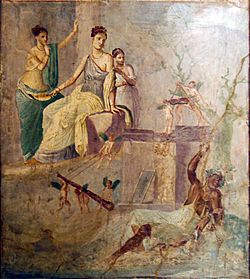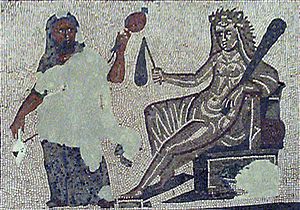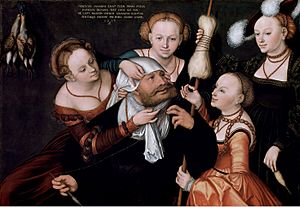Omphale facts for kids
Quick facts for kids Omphale |
|
|---|---|
| Queen of Lydia | |
| Member of the Royal House of Lydia | |

|
|
| Abode | Lydia |
| Personal information | |
| Consort | Tmolus, Heracles |
| Children | Sons by Heracles |
| Parents | Iardanus of Lydia |
In Greek mythology, Omphale was a powerful queen of the kingdom of Lydia. Lydia was a region in Asia Minor, which is now part of modern-day Turkey. Even though she was a queen, the ancient Greeks did not see her as a goddess. She is best known for her story with the famous hero Heracles. In this myth, Heracles had to serve her for one year.
Contents
Omphale's Family and Kingdom
Omphale was the daughter of Iardanus. He was either a king of Lydia or a river-god. Omphale was married to Tmolus, who was a mountain king. After Tmolus died from being attacked by a bull, Omphale became the queen and ruled Lydia on her own.
The Myth of Heracles and Omphale
Heracles' Punishment and Service

The great hero Heracles (also known as Hercules by the Romans) had accidentally killed a man named Iphitus. As a punishment, the Delphic Oracle ordered Heracles to become a slave for one year. He was sent to serve Queen Omphale in Lydia. The money paid for his service was given to Iphitus's father, though some stories say Iphitus's sons accepted it.
During this time, Heracles was forced to do things that were usually considered women's work. He even wore women's clothes and spun wool. Omphale, on the other hand, sometimes wore Heracles's famous lion skin and carried his large club. This showed how their roles were swapped.
Heracles' Adventures in Lydia

Even while serving Omphale, Heracles still went on many adventures. He captured the city of the Itones and defeated Syleus, who forced travelers to work in his vineyard. He also captured the tricky Cercopes. Heracles even found and buried the body of Icarus. He also took part in the famous Calydonian boar hunt and the journey of the Argonautica.
Heracles and Omphale's Relationship
After some time, Omphale set Heracles free. They then fell in love and got married. One night, they planned to celebrate a special event for the god Dionysus. Heracles was sleeping alone in a bed. The god Pan tried to sneak into the bed, thinking it was Omphale. But it was Heracles, who quickly threw Pan to the floor. Heracles then laughed at Pan's mistake.
Omphale's Sons with Heracles
Heracles and Omphale had several sons. Different ancient writers mention different names for their children.
- Diodorus Siculus and Ovid mention a son named Lamos.
- Another ancient text, Bibliotheca, names their son as Agelaus.
- Pausanias mentions a son named Tyrsenus. This Tyrsenus is said to have invented the trumpet. His son, Hegeleus, taught others how to play it.
The name Tyrsenus is also linked to the Etruscans in Italy. Some stories say that Tyrrhenus, a son of Heracles and Omphale, led people from Lydia to settle in Italy.
Historians like Herodotus also wrote about a line of kings in Lydia who were descended from Heracles. These kings were called the Heraclids. One story says that the first Heraclid king in Sardis was Agron. He was a descendant of Heracles through a son named Alcaeus.
Omphale in Art and Culture

The story of Omphale and Heracles has inspired many artists and writers throughout history:
- Opera: Omphale is an opera created by the French composer André Cardinal Destouches in 1701.
- Music: The French composer Camille Saint-Saëns wrote a famous piece of music called Le Rouet d'Omphale ("The Spinning Wheel of Omphale"). This music was later used as the theme for the radio show The Shadow.
- Plays: A play called Hercules and Omphale or The Power of Love was performed in London in 1864. In this play, Heracles was played by a woman. The story also appears in August Strindberg's play The Father, where a character compares his wife's actions to Omphale's treatment of Heracles.
- Paintings: The German painter Lucas Cranach the Elder created a painting called Hercules und Omphale. It shows Heracles dressed as a woman, spinning wool, while Omphale and her maids watch.
- Poetry: The French poet Guillaume Apollinaire wrote a short poem titled "Hercule et Omphale."
Omphale in Cinema
Queen Omphale is a main character in the movie Hercules Unchained, which is a sequel to the 1958 film Hercules. In the movie, Omphale captures men who drink from a special fountain that makes them forget everything. She makes them her "love slaves" and calls them king, but then has them killed when a new man arrives.
When Heracles drinks from this fountain, he also becomes Omphale's captive. His friend, Ulysses, pretends to be deaf and mute to stay on the island and help Heracles. Ulysses discovers a cave full of statues of Omphale's past victims. He secretly gives Heracles regular water, which helps Heracles regain his memory and escape the island. Omphale dies during Heracles's escape.
See also
 In Spanish: Ónfale para niños
In Spanish: Ónfale para niños

